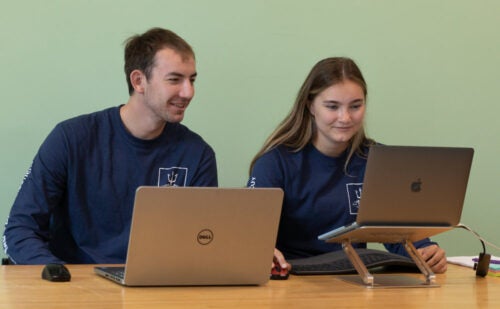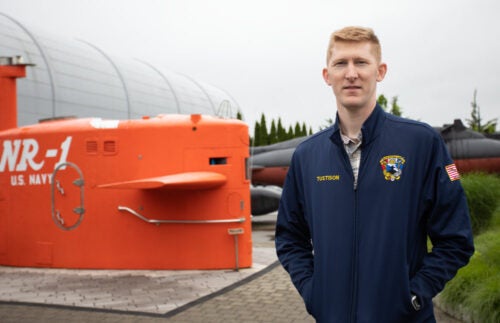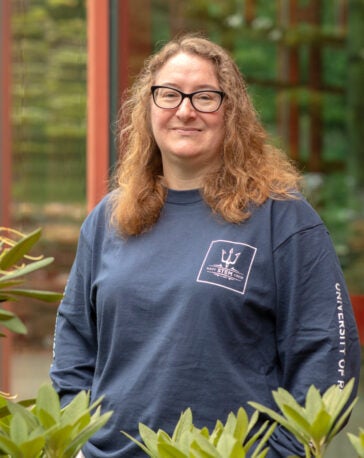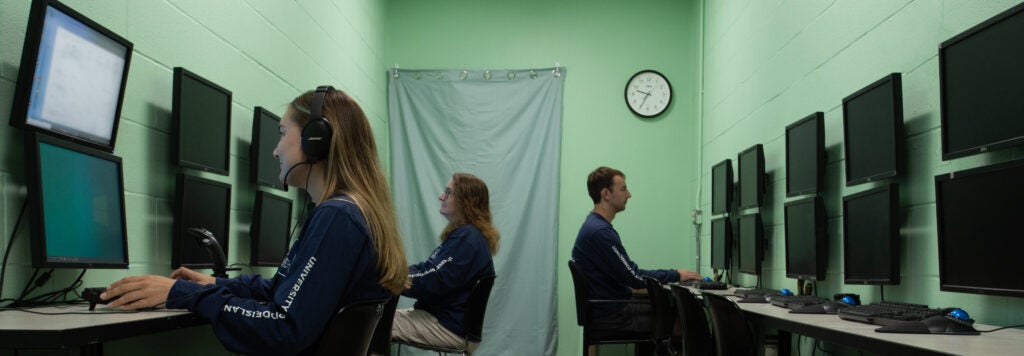The Fiber Optic Reel System, (FOReelS), allows for live-stream high bandwidth data transfers from deep-sea environments.
Through the innovative National Institute of Undersea Vehicle Technology, URI faculty and students are working directly with federal defense and private industries to advance naval technology and keep the U.S. submarine fleet ahead of the pack.
By Michael Blanding
Historically a dominating force beneath the sea, the United States commands a fleet of submarines and underwater vehicles that have far outstripped the capabilities of other countries. However, others like Russia and China are closing the gap on America’s underwater edge by investing huge sums in their naval resources.
“We are seeing tremendous competition from the outside world both for commercial and defense applications in the undersea domain,” says Arun Shukla, professor of mechanical, industrial, and systems engineering at the University of Rhode Island. “The gap between us and other countries used to be huge—now it’s not as far.”
To help maintain its supremacy, the U.S. Navy has turned to a unique partnership with URI, along with the University of Connecticut (UConn) and local industry partners to develop the next generation of submarines and deep-sea equipment. The National Institute of Undersea Vehicle Technology (NIUVT) facilitates the adoption of the latest research from URI and UConn faculty and students and speeds up the time for the cutting-edge research to be developed into underwater applications.
“It creates a massive opportunity for University faculty and students to work directly with national security organizations and defense industrial base partners on real-world challenges in areas of need for technological advancement,” says Erik Brine, director of URI’s Defense Sector R&D Initiatives and Operations. “For students, it creates great opportunities to work on projects that give them hands-on experience that will give them a leg up on the competition for their careers.”
URI’s ocean engineering students are converting a Blue Robotics BlueROV to fiber optic telemetry, allowing for high-bandwidth communication to the surface over long distances.
Custom fiber optic and ethernet connections are shown installed on a modified low cost unmanned underwater vehicle to allow operation from an unmanned surface vehicle.
Talks for NIUVT began six years ago among URI, UConn, General Dynamics Electric Boat in Groton, Conn., and the Naval Undersea Warfare Center (NUWC) in Newport, R.I. The joint effort launched in 2019 and expanded to include 16 government and industry partners with government grants of nearly $40 million so far.
“It’s been a game-changer,” says Dean Anthony Marchese of URI’s College of Engineering. “While we’ve always had strong partnerships with Electric Boat and NUWC, this center enables us to respond directly to the needs of our partners. At the same time, it provides great opportunities for faculty to develop their research programs in these areas.”
With three-quarters of the earth’s surface covered by oceans, submarines play a vitally important role in protecting the U.S. coastline and supporting military actions overseas. NIUVT fulfills the desire of Congress that the Navy make use of research and technologies developed in academia for both military and commercial purposes.
“NIUVT can help transition new technologies, new ideas, more rapidly into the next platform, the next design,” says Richard Christenson, UConn professor of civil and environmental engineering, and co-director of the institute with Shukla. “It’s one area where the partnership between industry, academia, and government can be very helpful.”
That technology transfer will power the Navy’s efforts to replace its aging submarine fleet with new state-of-the-art vehicles and develop new capabilities in unmanned underwater vehicles (UUVs). As one of only a handful of universities nationwide with a department of ocean engineering, URI is uniquely suited to its role in the partnership, providing advanced facilities and equipment—such as underwater test tanks—along with faculty working at the forefront of ocean science. In just three years, NIUVT has developed an impressive 88 applied research projects in a dozen technical areas. The institute includes 88 professors between the two universities, along with more than 50 engineers from Electric Boat.
Professor Arun Shukla looks at Craig Tilton, engineer, Naval Undersea Vehicle Technology, setting up an experiment inside a large pressure vessel.
Among the NIUVT research areas is an effort, led by Shukla, to better understand how vehicles and other objects submerged miles under the ocean respond to underwater shock.
“We expose them to explosive loadings and then look at their structural integrity and other features such as the pressure pulses that reflect back from them,” Shukla says.
URI’s Dynamic Photo-Mechanics Lab (DPML), which houses Shukla’s underwater shock effort, has been working closely with the U.S. Navy over the last four decades and has transitioned more than 40 graduate students to the Navy enterprise. Several employees from NUWC and Electric Boat are currently working on their graduate degrees at DPML.
Other areas of research include acoustics and sensors, led by URI ocean engineering professor James Miller (see “Seeing Without Sound,” below); advanced manufacturing processes, led by URI mechanical, industrial and systems engineering professor Manbir Sodhi; marine hydrodynamics, led by URI ocean engineering associate professor Jason Dahl; and human factors research, led by URI mechanical, industrial and systems engineering associate professor Valerie Maier-Speredelozzi (see “The Human Side of Sub Tech,” below).
The institute also has created a pipeline of experienced students to replace an aging workforce of engineers. Since it launched, NIUVT has employed more than 100 students and postgraduate researchers on projects. Among them, nine doctoral and 25 master’s students have already entered jobs in government or industry.

“Students who grow up in this area or gravitate to URI often have an intimate interest in and knowledge of the sea,” says Marchese. “They get to work on these projects as part of their degree program, and then they are able to stay in the region and go to work for the Navy or Electric Boat or other local businesses, so it’s a win-win.”
In addition to those larger businesses and institutions, there are approximately 600 large and small companies that cater to shipbuilding and other naval industries in Connecticut and Rhode Island. That concentration has led to the area being known as the Blue Corridor, or as former Defense Secretary Chuck Hagel called it, the “Silicon Valley of undersea technology.” NIUVT is solidifying that reputation by fulfilling vital national security interests and spurring the area’s economy.
“We really appreciate the fact that somebody looking from the outside feels that we are better than most people in the country to work at this top level,” Shukla says. “It gives our graduate students an opportunity to work on the cutting edge of technology of interest to our country and helps get them jobs.” •
Seeing with Sound
Fans of the movie The Hunt for Red October will remember the scene in which the Russian submarine captain played by Sean Connery uses sonar to verify the range of an American submarine, while trying not to give away its own location.
“One ping only,” the captain famously tells his subordinate as he gets ready to send the signal.

Reality underwater is not too far off from the movies, says URI ocean engineering professor James Miller. “The ocean is dark and deep and light doesn’t go very far, so the only way to see any distance at all is through sound,” he says. “Submarines hide under the sea, and the only way to find them is acoustically.”
As lead for NIUVT’s Acoustics, Sensors, and Signal Processing program, Miller coordinates a range of projects to help the Navy hide its own submarines and find enemy submarines. His work is leading to a better understanding of how sound propagates in different ocean environments based on the sediment of the ocean floor.
“It’s like if you are a hallway without a carpet, where there are a lot of echoes; versus a hallway with carpeting, where it’s much quieter,” says Miller, who is collaborating with URI research professor of ocean engineering Gopu Potty. “If you have an ocean floor with soft bottoms, you can’t hear the submarines as far as you can where the sediment is much harder.”
NIUVT’s relationships with the Navy and industry, Miller says, “shorten the time between when we find something out and someone cares about it in the real world.”
At the same time, Miller adds, NIUVT provides funding to hire students to go out on ships and perform experiments in acoustic test tanks in the lab. “Instead of just one or two students, I may have six,” he says. “It really increases the pace at which we can perform research.”
Among Miller’s students are several active-duty Naval officers who are earning their degrees as part of their shore duty.
“It’s fascinating for me to have the opportunity to learn more about the physical properties of the ocean, especially in complex environments,” says Nathan Tustison, a nuclear submarine officer pursuing his master’s in ocean engineering with Miller at URI. “It helps me perform personally at a higher level, and also helps me train others that I work with.”
Other projects within Miller’s program include work by URI assistant professor of ocean engineering Lora Van Uffelen on acoustic sea gliders that can receive signals over long distances to aid in navigation; and efforts by URI professor of civil, environmental, and ocean engineering Chris Baxter and assistant professor of ocean engineering Brennan Phillips to develop new high bandwidth fiber-optic sensors to quickly measure ocean and seabed properties.
The Human Side of Sub Tech
The most advanced submarine technology in the world doesn’t matter if the people manning the subs can’t use it.

“You can’t have people in intense situations who are not able to use systems efficiently and effectively,” says URI’s Valerie Maier-Speredelozzi, associate professor of mechanical, industrial and systems engineering. “They have to be able to make the right decision at a moment’s notice and hit the right button or locate necessary equipment or tools.”
Maier-Speredelozzi has worked for years on human factors research with industrial companies to design better workspaces. NIUVT has provided the opportunity to form new partnerships with the Navy and industry to improve conditions for sailors. “It’s been exciting to be able to work more closely with our local naval defense industries,” she says. “In military operations, sailors must be comfortable standing watch for long hours, and must be able to see all the different sensors and instrumentation. We want to make things ergonomically comfortable and build in error-proofing.”
In one project, a collaboration between industrial engineering and textile design faculty, Maier-Speredelozzi is helping design better personal protective equipment for welding. In another project, she is looking at the effects of fatigue on performance. To do so, she transformed an entire room in URI’s Kirk Applied Engineering Laboratory into a simulation of a submarine control room to create a realistic environment in an unclassified setting. “We can put people into a scenario and look at how individuals and teams perform and interact with systems,” she says.

By partnering with URI, Maier-Speredelozzi says, the Navy gains valuable insight into the human side of military technology that they may not have the time or resources to investigate themselves. “The University can really help to look at problems that go beyond the day-to-day,” she says. “We can look at issues with a bit longer time horizon or things that may be on the back burner and provide a new perspective by getting students looking at it.”
Maier-Speredelozzi has been connected to the military her entire life through various family members, and that makes the opportunity to collaborate to keep sailors safe and comfortable during their tours at sea even more meaningful. “It’s been really great to be able to contribute to the nation’s defense missions and to support all of our people in the military,” she says.
A view of a thruster module for a low-cost unmanned underwater vehicle (UUV)
This story was written for Momentum: Research & Innovation and University of Rhode Island Magazine.
Photo Credit: Beau Jones. Homepage image: Arun Shukla, Simon Ostrach professor, co-director NIUVT, Mechanical and Industrial Systems Engineering

My husband, Peter Van Schuyler, class of’65 worked in Anti- sub- warfare with the US Navy for 35 years. (1960-1993). His last base was Warminster, PA (NADC). We now live in Sunbury PA.
Naval Air Defense Center has moved to Pax River in Maryland
The U.S. needs to establish underwater leases for rare earth nodules located in the Pacific Ocean between Hawaii and California. What part has URI played regarding this necessary computer component.